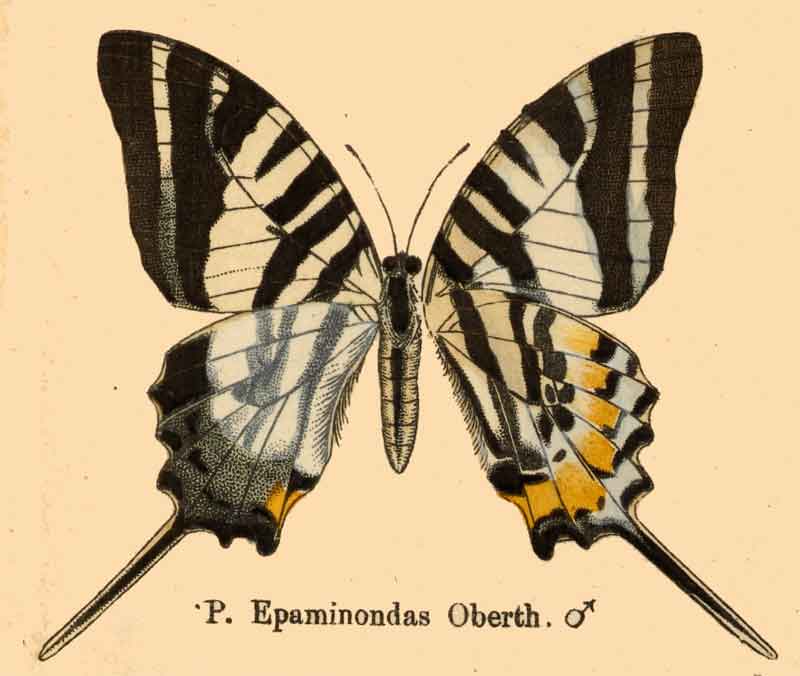
Superregnum: Eukaryota
Regnum: Animalia
Subregnum: Eumetazoa
Cladus: Bilateria
Cladus: Nephrozoa
Cladus: Protostomia
Cladus: Ecdysozoa
Cladus: Panarthropoda
Phylum: Arthropoda
Subphylum: Hexapoda
Classis: Insecta
Cladus: Dicondylia
Subclassis: Pterygota
Cladus: Metapterygota
Infraclassis: Neoptera
Cladus: Eumetabola
Cladus: Endopterygota
Superordo: Panorpida
Cladus: Amphiesmenoptera
Ordo: Lepidoptera
Subordo: Glossata
Cladus: Coelolepida
Cladus: Myoglossata
Cladus: Neolepidoptera
Infraordo: Heteroneura
Cladus: Eulepidoptera
Cladus: Ditrysia
Cladus: Apoditrysia
Cladus: Obtectomera
Superfamilia: Papilionoidea
Familia: Papilionidae
Subfamilia: Papilioninae
Tribus: Leptocircini
Genus: Graphium
Subgenus: Graphium (Pathysa)
Species: Graphium epaminondas
Name
Graphium (Pathysa) epaminondas (Oberthür, 1879)
Graphium epaminondas, the Andaman swordtail, is a beautiful butterfly found in India that belongs to the swallowtail family. It was earlier considered a subspecies of fivebar swordtail (Graphium antiphates) but has now been identified as a separate species.
Range
Plate accompanying Oberthür's 1879 description
Though endemic to the Andaman Islands of India, its distribution is insufficiently known. It has been seen in good numbers in Mount Harriet National Park and other locations in the Andamans.[2]
Description
It differs from Graphium antiphates chiefly in the greater width of the black markings on the upperside, especially of the basal and subbasal bands that cross the forewing, both of which also extend to the dorsum. On the hindwing the black markings of the underside on the basal and discal areas are not only seen by transparency from below, but are actually represented, though only partially, by black scaling; the width of the dark grey terminal portion is also greater, and it has a tendency to turn to dusky black anteriorly, so that the sub-terminal series of black lunules are obscured anteriorly and are difficult to make out. Underside: markings similar to those of the typical form, but broader; forewing with the discal transverse band that reaches from costa to vein 1; hindwing: the black bands that cross the cell broader and proportionately closer together.[3]
Has a 94–100 mm expanse.
Status
Insufficiently known.
Etymology
Named in the classical tradition to honour the Theban general Epaminondas.
See also
Papilionidae
List of butterflies of India
List of butterflies of India (Papilionidae)
References
Gimenez Dixon, M. (1996). "Graphium epaminondas". IUCN Red List of Threatened Species. 1996: e.T9471A12991330. doi:10.2305/IUCN.UK.1996.RLTS.T9471A12991330.en. Retrieved 18 November 2021.
Veenakumari, K. and Prashanth Mohanraj 1997. Rediscovery of Lethe europa tamuna with notes on other threatened butterflies from the Andamans and Nicobar Islands. Journal of the Lepidopterists' Society. 51(3):273-275 PDF[permanent dead link]
Bingham, C.T. (1907). The Fauna of British India, Including Ceylon and Burma. II (1st ed.). London: Taylor and Francis, Ltd.
General reading
Collins, N. Mark; Morris, Michael G. (1985). Threatened Swallowtail Butterflies of the World: The IUCN Red Data Book. Gland & Cambridge: IUCN. ISBN 978-2-88032-603-6 – via Biodiversity Heritage Library.
Evans, W.H. (1932). The Identification of Indian Butterflies (2nd ed.). Mumbai, India: Bombay Natural History Society.
Retrieved from "http://en.wikipedia.org/"
All text is available under the terms of the GNU Free Documentation License

